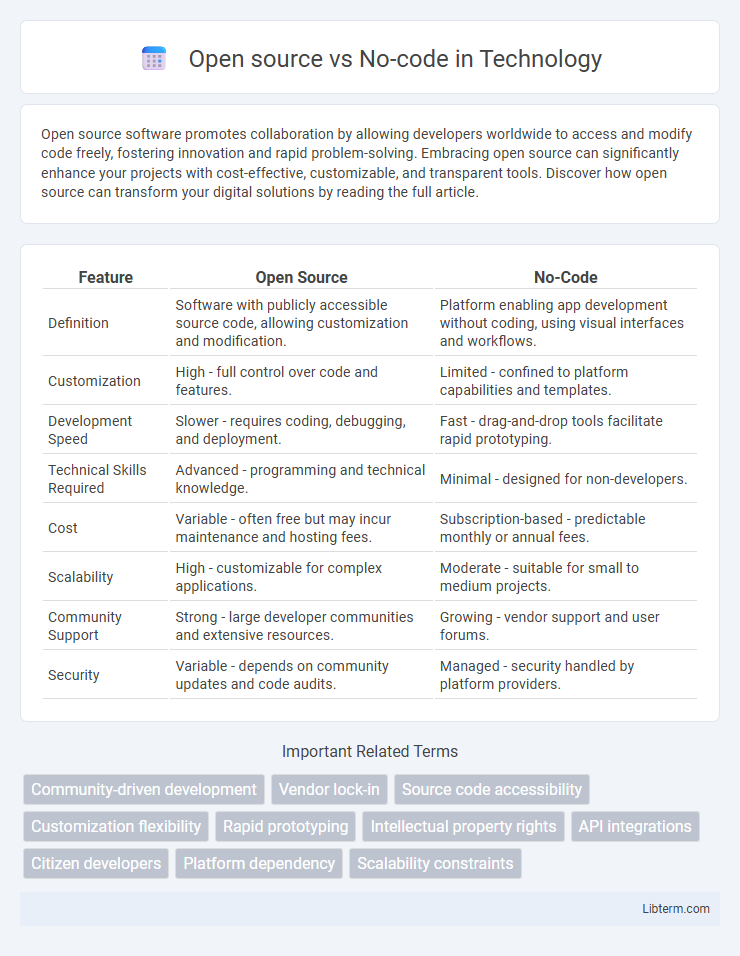Open source software promotes collaboration by allowing developers worldwide to access and modify code freely, fostering innovation and rapid problem-solving. Embracing open source can significantly enhance your projects with cost-effective, customizable, and transparent tools. Discover how open source can transform your digital solutions by reading the full article.
Table of Comparison
| Feature | Open Source | No-Code |
|---|---|---|
| Definition | Software with publicly accessible source code, allowing customization and modification. | Platform enabling app development without coding, using visual interfaces and workflows. |
| Customization | High - full control over code and features. | Limited - confined to platform capabilities and templates. |
| Development Speed | Slower - requires coding, debugging, and deployment. | Fast - drag-and-drop tools facilitate rapid prototyping. |
| Technical Skills Required | Advanced - programming and technical knowledge. | Minimal - designed for non-developers. |
| Cost | Variable - often free but may incur maintenance and hosting fees. | Subscription-based - predictable monthly or annual fees. |
| Scalability | High - customizable for complex applications. | Moderate - suitable for small to medium projects. |
| Community Support | Strong - large developer communities and extensive resources. | Growing - vendor support and user forums. |
| Security | Variable - depends on community updates and code audits. | Managed - security handled by platform providers. |
Understanding Open Source: Definition and Key Features
Open source software is defined by its publicly accessible source code, allowing users to inspect, modify, and distribute it freely. Key features include transparency, community collaboration, and customization, enabling rapid innovation and adaptability. Unlike no-code platforms, open source offers granular control over development but generally requires programming knowledge.
What is No-Code? Core Concepts and Benefits
No-code platforms empower users to build applications through visual interfaces without writing traditional code, leveraging drag-and-drop components, pre-built templates, and automation tools. Core concepts include user-friendly design, rapid prototyping, integration capabilities, and workflow automation, enabling business users and developers to collaborate efficiently. Benefits encompass accelerated development cycles, cost reduction, easier maintenance, and accessibility for non-technical users to create custom solutions.
Flexibility and Customization: How They Differ
Open source platforms offer unparalleled flexibility and customization by allowing users to modify source code, integrate third-party tools, and tailor functionalities to specific needs. No-code solutions prioritize ease of use with drag-and-drop interfaces but often impose limitations on customization and advanced feature integration. Choosing open source supports deeper technical control and scalability, while no-code emphasizes rapid deployment with predefined templates and limited adaptability.
Speed of Development: No-Code vs Open Source
No-code platforms significantly accelerate development speed by providing pre-built templates, drag-and-drop interfaces, and automated workflows, enabling users to launch applications within hours or days without extensive coding knowledge. Open source solutions offer greater customization and control but typically require more time for setup, coding, and debugging, especially for complex projects. Teams seeking rapid prototyping and deployment often prefer no-code, whereas open source suits projects demanding flexibility and scalability despite longer development cycles.
Cost Comparison: Open Source vs No-Code Platforms
Open source platforms often require lower upfront costs since their software is freely available, but expenses can arise from hosting, customization, and ongoing maintenance. No-code platforms typically involve subscription fees or usage-based pricing that covers hosting and support, offering predictable costs but potentially higher total expenses at scale. Businesses must evaluate long-term investments, considering factors like development resources for open source versus ease of use and faster deployment in no-code environments.
Community Support and Resources: Which is Stronger?
Open source platforms benefit from extensive community support with millions of developers contributing to forums, repositories, and documentation, providing robust resources for troubleshooting and customization. No-code platforms offer specialized support through dedicated user communities, tutorials, and vendor assistance, but their communities are typically smaller and less technical. For expansive technical collaboration and diverse resources, open source communities are generally stronger and more dynamic.
Scalability and Performance Considerations
Open source platforms offer extensive scalability due to customizable codebases, enabling fine-tuned performance optimizations suited for high-demand applications. No-code solutions, while accelerating development timelines, often face limitations in handling complex, large-scale operations and may introduce performance bottlenecks under heavy user loads. Evaluating scalability and performance requirements is crucial for selecting between open source flexibility and no-code speed in enterprise environments.
Security Implications: Evaluating Risks and Protections
Open source platforms offer transparency and community-driven security audits, reducing hidden vulnerabilities but requiring users to manage updates and patches actively. No-code solutions centralize security controls and compliance management, simplifying protection but creating dependency on vendor policies and potentially increasing risk exposure if the provider is compromised. Evaluating risks involves assessing control over data, update frequency, incident response capabilities, and the trustworthiness of the development community or vendor.
Ideal Use Cases for Open Source and No-Code
Open source software is ideal for developers seeking full customization, scalability, and control over the codebase, especially in complex projects requiring integrations, security, and flexibility. No-code platforms suit business users and startups looking to rapidly prototype, launch, or automate workflows without technical expertise, enabling faster time-to-market and cost efficiency. Enterprises benefit from open source for long-term, scalable solutions, while no-code accelerates innovation in non-technical areas such as marketing, sales, and operations.
Making the Right Choice: Factors to Consider
Choosing between open source and no-code platforms depends on factors like customization needs, technical skill levels, and project complexity. Open source offers extensive flexibility and control for developers who can manage code, while no-code platforms enable rapid development with minimal programming knowledge. Consider scalability requirements, budget constraints, and long-term maintenance when making the right choice.
Open source Infographic

 libterm.com
libterm.com